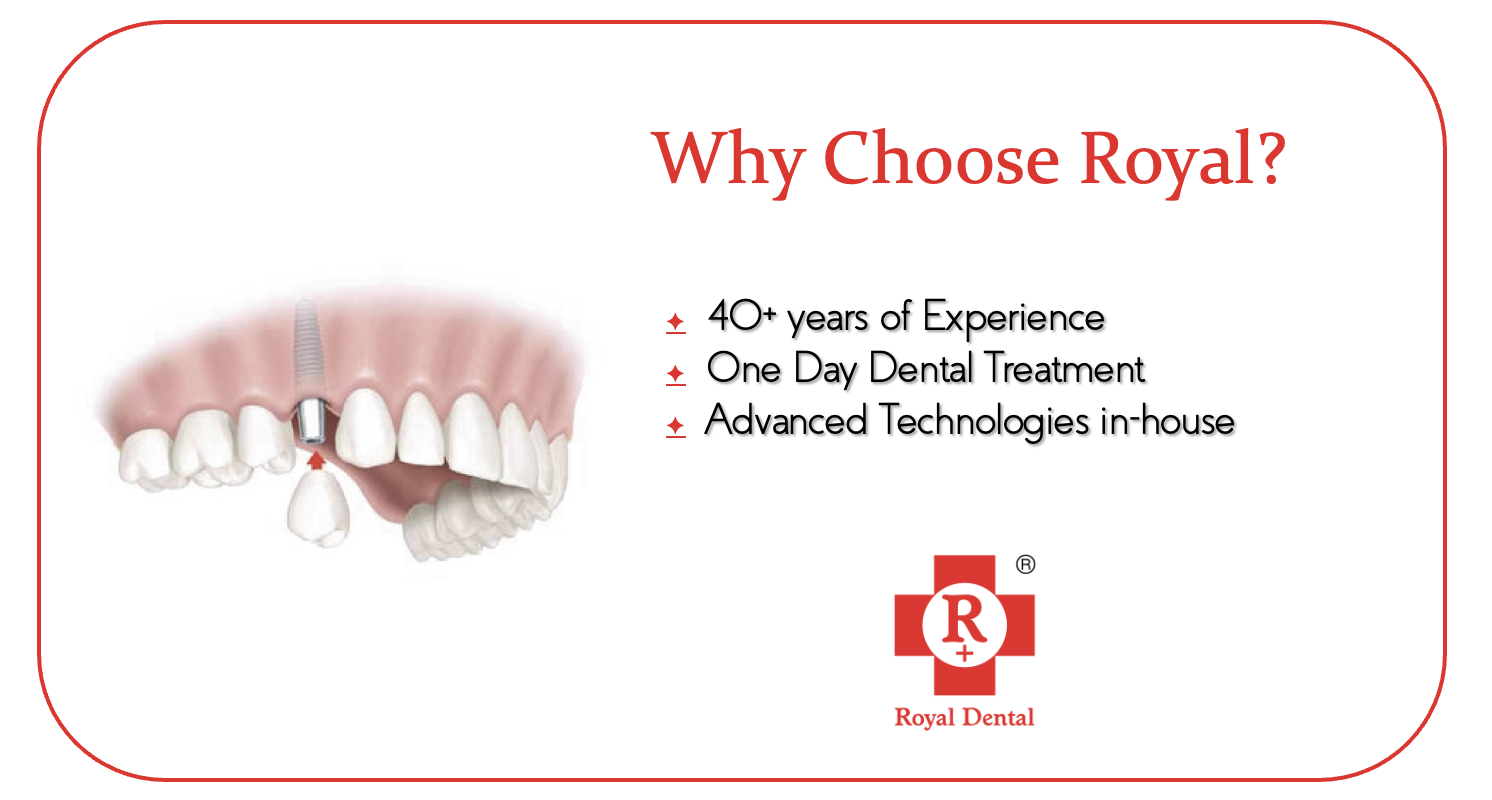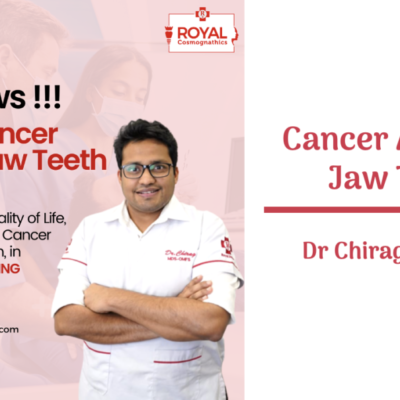Missing teeth affects the esthetics and overall facial appearance of an individual. If missing teeth including upper and lower teeth are not replaced in time, it can cause problems. These may include pathological migration of teeth, supra-eruption, speech and chewing ability, malocclusion or decrease the integrity of jaw bone. Know more about teeth implants.
This in turn will cause hindrance to oral hygiene. Speech and phonetics hampered if teeth not in proper alignment. As more teeth one chew from other areas. This causes overload on certain teeth with excessive wear and tear and TMJ dysfunction. Improper chewing may lead to poor nutrition thereby affecting overall growth and health of the patient.
Missing teeth negatively affects the appearance of your face and smile. This further may lead to poor professional and social performance. This overall affects the patient’s quality of life. We are here to protect your smile for a million reasons.
Royal Dental Clinics
Challenges in Upper Jaw Teeth Implants
Weaker Bone: When compared to mandible, the implant placement in maxilla posterior region is challenging as the bone here is the least dense. For implant placement, type and density of bone plays a vital role. Hence due to unfavourable bone quality in posterior maxilla, dental implant placement should be carried out with maximum attention for achievement of successful results.
Maxillary Sinus: This is a pyramid shaped cavity. The size of the sinus increases with age and also after extraction or tooth loss of maxillary molar teeth. This sinus pneumatization. The extent of pneumatization varies from person to person and from side to side. This leads to deficiency in bone height for implant placement thus requiring sinus or bone augmentation. Another way of bypassing the sinus is use of tilted implants.

Restoring Upper Missing Teeth
Removable Dentures
Partial Dentures: It is one of the oldest way of replacing missing teeth. Removable dentures are for partially edentulous patients who want to have replacement of teeth. For functional or aesthetic reasons and who cannot have a dental bridge for reasons such as lack of healthy adjacent teeth or financial limitations. These removed and reinserted when required with a dentist’s help.
Complete Dentures: It is given when all teeth are missing within the jaw. They are tissue supported. For thin or very less amount of bone, complete dentures may be given over the implants for a proper fit.

Dental Implants
Nowadays, Dental implants are a great way to replace missing upper teeth. These fuse to jaw bone by process called osseointegration which is a process of formation of healthy bone around implants. This helps to keep the implant firm further aiding in mastication, occlusion and acting as an aid for natural tooth.
Dental implants serve as an excellent treatment modality and it is the choice of treatment for young as well as elderly patients in cases of missing teeth.
Dr Chirag Chamria
Dental Implant types to replace Upper Missing Teeth:
Endosteal: They are most commonly placed into the jaw bone.
Sub-periosteal: They are also placed into the jaw bone but they rest on the top of the jaw bone. A metal frame is placed under the gums with a post attached to it. This done in cases where patient is not having enough jaw bone to support the implant.
Survival rate of Dental Implants according to a study report is 5 years. Whereas the same for dentures is 92%. Implants are a one day procedure.
Sinus Lift with Dental Implants
Sinus lift surgery is a treatment approach which dentist may recommend when you desire dental implants but don’t have enough jaw bone to secure the implant. Several kinds of medical specialists may perform this procedure, such as a periodontists or oral surgeons.
A sinus lift refers to the augmentation or lifting up of the maxillary sinus to make more room for new bone. The maxillary sinuses air-filled cavities that located just above the back portion of the maxilla or upper jaw. By lifting the sinus and grafting bone in between, there’s more bone for a doctor to place a dental implant.

Get Dental Implants for Upper Missing Teeth!
In addition, if you don’t have enough upper jaw bone, the implant can’t properly anchor. Furthermore, your new dental implant can’t perform some more demanding tasks, such as chewing. Without enough bone, the dental implant won’t properly secure and can fail.
Also, bone in the jaw can be a use-it-or-lose-it prospect. If you have experienced tooth loss, your jawbone may start to get thinner over time. Foundation for Oral Rehabilitation doctors will recommend sinus lift surgery if they determine you have less than 4 to 6mm of bone.
Zygomatic Dental Implants with SAPTeeth
They are long, angled endosseous implants placed into the zygoma as an augmentation procedure in severely atrophic maxilla. they anchored into the zygomatic bone. Zygomatic Implants avoid grafting and sinus lift procedures and thereby contribute to a shorter and less invasive treatment. They recommended in cases involving failed dental implants, failed bone grafting operations and extreme jaw bone efficiency.

Pterygoid Implants
Pterygoid implants known as “pterygo-maxillary implants”. These implants allow patients with severe upper jawbone loss to enjoy the benefits of a dental implant. The primary reason for using implants in the pterygoid region is the availability of dense cortical bone for implant engagement. Furthermore, it also helps to overcome the need for maxillary sinus elevation. Above all, bone grafting procedures. Surgical placement of pterygoid implants is straightforward for an experienced clinician and performed under local anaesthesia in a dental office.
This is in contrast to zygomatic implants, which usually entail a larger surgical procedure and require sedation or general anaesthesia. This can shorten the treatment time and allows immediate loading of the pterygoid implant. Furthermore, it allows the fabrication of a partial arch or complete arch prosthesis, allows for sufficient posterior extensions, eliminating the need for detrimental distal cantilevers, and is biomechanically advantageous.







royal dantel clinic are very good to this clinic